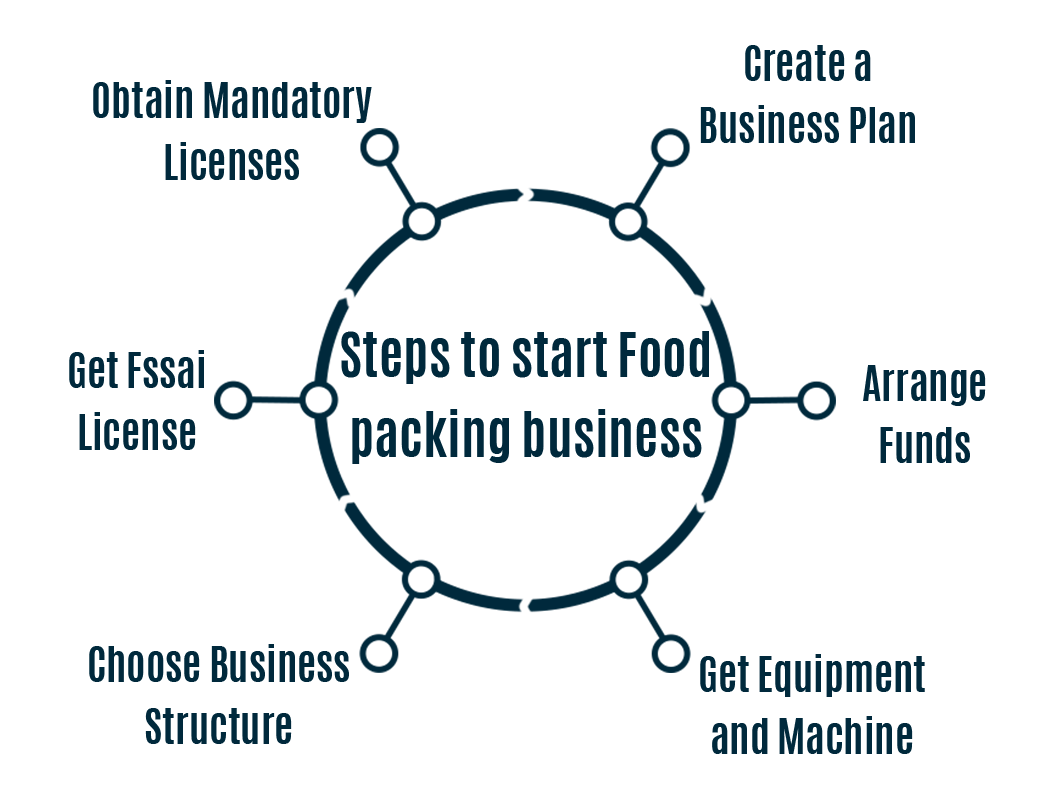
Get a Quote
Get a Quote and Find Services to Fit Your Needs 50000+ Satisfied Clients
5000+ Licenses & Registration
15 Branches across India
75 Years + Combined experience
Packaging is an important step for preserving food items for the longer term and keeping them safe during transportation from one place to another. The packing business in India has witnessed significant growth over the past decade.
The preferences of consumers have changed for food packaging businesses, now they look for advanced packaging technology which keeps the food product fresh and consumable. With the increase in demand, food businesses are adopting different technologies and practices to keep the demand in the market. Here in this article, a step-by-step guide is given to set up a food packaging business by obtaining a packing License
The types of packaging used in the food packaging business are classified based on their use in primary packaging, secondary packaging, tertiary packaging, and ancillary packaging.

Primary packaging refers to the packaging which comes directly in contact with the product. For example - the water bottle, the wrapper that holds the candy bar. Other examples are glass, flexible pouches, aluminium cans, foil paper etc. The main function of primary packaging is to protect the product from contamination and preserve its quality and freshness.
The term secondary packaging is given to the packaging which comes over the primary packaging. Usually, it is used during transportation and storage. Information about the product is written on this such as barcode, way of usage, price, manufacturing and expiry date, etc. Examples of secondary packaging are cardboard, plastic bags, and shrink papers. It ensures that products reach consumers safely.
This type of packaging is used to transport and store large quantities. Examples - pallets, wooden containers, metal drums, etc. Mainly it makes sure the efficient and safe handling, storage and distribution of products.
Ancillary packaging is used to protect the other components of products such as instruction manuals, warranty cards, and promotional materials. So, this packaging ensures that the components reach the end consumer safely. Examples - envelopes, pouches and sleeves.
Below is a step-by-step guide which should be followed by a food packing business to obtain a food packaging license and set up the packaging company.

To show your plans and ideas related to the business requires a plan where you write all the steps that need to be followed. So, others can follow your idea based on the business plan. To create the right business plan, take the below points into account.
To run a business, funds and capital are required and there are many ways to obtain the funds. Here you can choose crowdfunding, and business loans from banks. Other than this you can approach Angel Investors and Venture Capitalists who can invest or contribute to your business. Also, there are various schemes that provide financial help. These schemes are Production Linked Incentive Scheme for Food Processing Industry (PLISFPI) scheme, and Pradhan Mantri Krishi Sinchayee Yojana (PMKSY).
Once you created the proper business plan, the next step includes the procurement of important machines and equipment for manufacturing. So, the size of the machine will depend on the area of the unit where the packing company will set up. But before purchasing the equipment make sure you have a complete list of clients' equipment and must know the technical specifications to avoid future trouble.
It is a third but important step, here you have to complete the packaging license registration and choose a business structure such as LLP, private limited company, OPC, partnership firm, etc. Let’s check how you can choose the right business structure that fits your requirements.
Assume you have a framework that includes Directors and shareholders who are managing the business. Here, in this case, you should choose a structure such as a private limited company, or public limited company by law.
The same concept will apply to LLP and partnership but there is a limit on the number of members included in the business. One-person company is a different method which is also chosen by many businesses because here you are the only person who manages all the work.
Note: Every business has different ways of conducting, so the rules and regulations all differ. To obtain a food packaging license in India, wisely choose the structure as per the pros and cons.
Every business which is included in the food business must acquire an FSSAI packer license in India. According to the FSSAI Act, of 2006, there are three types of packaging license registration. The type of registration will depend on the food packing business size and annual turnover.
To apply for the packing license you must fulfill the requirement of annual turnover of below Rs. 12 lakhs. Apply for the state FSSAI license when your annual turnover is above Rs. 12 lakhs but below Rs. 20 crores. And, when your turnover exceeds Rs. 20 crores, then you can obtain a Central FSSAI License.
Get a fire department NOC for your business, and also get a water testing certificate from the certified agency. This certificate is important because the water which is used to prepare the food items will be safe from any impurities. Other packing license registration includes:
So, after getting all the required licenses, you need to obtain the staff for your packaging business. You have to hire people for various designations, such as factory workers, cooks, marketing, sales, managers, HR managers, etc.
Food item demand is rising in the market rapidly because people these days prefer to take food items with them to their offices, picnic, traveling, and at different places. The convenience that came with packaged food items makes it a popular business. So, if you are looking to set up a food packing business in India, then you must follow the above-mentioned steps and obtain a packing license to avoid any legal consequences.

Want to know More ?